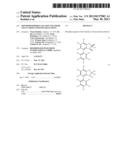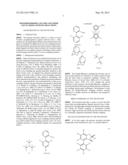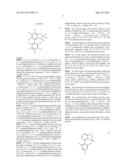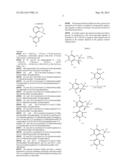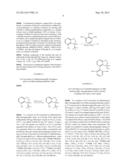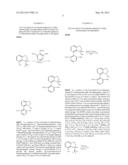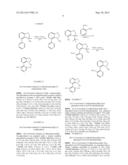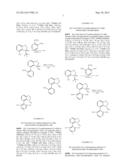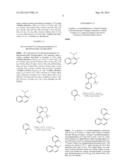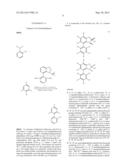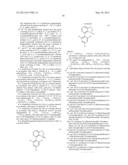Patent application title: Monophosphorus Ligands And Their Use In Cross-Coupling Reactions
Inventors:
Nizar Haddad (Danbury, CT, US)
Nizar Haddad (Danbury, CT, US)
Bo Qu (Brookfield, CT, US)
Bo Qu (Brookfield, CT, US)
Sonia Rodriguez (New Milford, CT, US)
Sonia Rodriguez (New Milford, CT, US)
Chris Senanayake (Brookfield, CT, US)
Wenjun Tang (Southbury, CT, US)
Wenjun Tang (Southbury, CT, US)
Xudong Wei (Ridgefield, CT, US)
Xudong Wei (Ridgefield, CT, US)
Nathan K. Yee (Danbury, CT, US)
Nathan K. Yee (Danbury, CT, US)
Assignees:
BOEHRINGER INGELHEIM INTERNATIONAL GMBH
IPC8 Class: AC07F96571FI
USPC Class:
568 12
Class name: Organic compounds (class 532, subclass 1) phosphorus containing ring phosphorus containing
Publication date: 2013-05-30
Patent application number: 20130137902
Abstract:
Phosphine ligands of the formula Ia, IB and mixtures thereof.
##STR00001##Claims:
1. A compound of the formula (Ia), (Ib), or a mixture thereof:
##STR00017## wherein: R is (C1-C6)-alkyl, CF3,
(C3-C10)-carbocyclyl, (5- to 11-membered)heterocarbocyclyl,
(C6-C10)aryl, (5 to 11-membered)heteroaryl, or ferrocenyl, wherein
each such (C3-C10)carbocyclyl, (5- to
11-membered)heterocarbocyclyl, (C6-C10)aryl or (5 to
11-membered)heteroaryl group is optionally substituted with 1 to 3
substituents independently selected from the group consisting of
--O(C1-C6)alkyl, (C1-C6)alkyl, and CF3; R1,
R2, R3, R4, R5 are each independently selected from
the group consisting of H, halo, CF3, --O(C1-C6)alkyl,
(C1-C6)alkyl, (C3-C10)carbocyclyl, (5- to
11-membered)heterocarbocyclyl, (C6-C10)aryl, (5 to
11-membered)heteroaryl, --NR11R12, --Si(R11)3 and
--SR11, wherein each such (C3-C10)carbocyclyl, (5- to
11-membered)heterocarbocyclyl, (C6-C10)aryl or (5 to
11-membered)heteroaryl group is optionally substituted with 1 to 3
substituents independently selected from the group consisting of
--O(C1-C6)alkyl, (C1-C6)alkyl and CF3; or any
two adjacent instances of R1, R2, R3, R4, R5,
taken together with the carbons to which they are bound, form a five- or
six-membered substituted or unsubstituted aryl or heteroaryl ring;
provided that at least one of R1, R2, R3, R4, R5
are OR11; R6, R7, R8 are each independently selected
from the group consisting of H, CF3, --O(C1-C6)alkyl,
(C1-C6)alkyl, (C3-C10)carbocyclyl, (5- to
11-membered)heterocarbocyclyl, (C6-C10)aryl, (5 to
11-membered)heteroaryl and --NR11R12; wherein each such
(C3-C10)carbocyclyl, (5- to 11-membered)heterocarbocyclyl,
(C6-C10)aryl or (5 to 11-membered)heteroaryl group is
optionally substituted with 1 to 3 substituents independently selected
from the group consisting of --O(C1-C6)alkyl,
(C1-C6)alkyl, and CF3; R9, R10 are each
independently selected from the group consisting of H,
(C1-C6)alkyl, (C3-C6)cycloalkyl, (3- to
6-membered)heterocycloalkyl, (C6-C10)aryl, (5- to
6-membered)heteroaryl, and --SiR.sup.5.sub.3; wherein each such
(C3-C6)cycloalkyl, (3- to 6-membered)heterocycloalkyl,
(C6-C10)aryl or (5- to 6-membered)heteroaryl group is
optionally substituted with 1 to 3 substituents independently selected
from the group consisting of --O(C1-C6)alkyl,
(C1-C6)alkyl, and CF3; and R11 and R12 are each
independently selected from the group consisting of H,
(C1-C6)alkyl, CF3, (C3-C10)carbocyclyl, (5- to
11-membered)heterocarbocyclyl, (C6-C10)aryl and (5 to
11-membered)heteroaryl, wherein each such (C3-C10)carbocyclyl,
(5- to 11-membered)heterocarbocyclyl, (C6-C10)aryl or (5 to
11-membered)heteroaryl group is optionally independently substituted with
1 to 3 substituents independently selected from the group consisting of
halo, --O(C1-C6)alkyl, (C1-C6)alkyl, and --CF.sub.3.
2. A compound of formula (Ia), (Ib), or a mixture thereof, in accordance with claim 1, wherein R is --(C1-C6)alkyl selected from --CH3, --CH2CH3, --CH(CH3)2, --C(CH3)3, --C(CH2CH3)3, and --C(CH2CH3)(CH3).sub.2.
3. A compound of formula (Ia), (Ib), or a mixture thereof, in accordance with claim 1, wherein R is --(C3-C10)carbocyclyl selected from cyclopentyl, cyclohexyl, and 1-adamantyl.
4. A compound of formula (Ia), (Ib), or a mixture thereof, in accordance with claim 1, wherein R is --(C6-C10)aryl selected from phenyl, ortho-tolyl, para-tolyl, 3,5-dimethylphenyl, 3,5-di-t-butylphenyl, 3,5-di-CF3-phenyl, ortho-CF3-phenyl, ortho-anisyl, and naphthyl.
5. A compound of formula (Ia), (Ib), or a mixture thereof, in accordance with claim 1, wherein R1, R2, R3, R4, R5 are each independently H, --CH3, --CH2CH3, --CH(CH3)2, --C(CH3)3, --OCH3, --OCH2CH3, --OCH(CH3)2, N(CH3)2, N(CH2CH3)2, or SiMe.sub.3.
6. A compound of formula (Ia), (Ib), or a mixture thereof, in accordance with claim 1, wherein R6, R7, R8 are H.
7. A compound of formula (Ia), (Ib), or a mixture thereof, in accordance with claim 1, wherein R9 and R12 are each independently H, --CH3, --CH2CH3, --CH(CH3)2, --C(CH3)3, phenyl, ortho-tolyl, para-tolyl, 3,5-dimethylphenyl, 3,5-di-t-butylphenyl, 3,5 di CF3 phenyl, ortho-CF3-phenyl, ortho-anisyl, 2,6-dimethoxyphenyl or naphthyl.
8. A phosphine ligand having the formula (IIa) or (IIb), or a mixture thereof, ##STR00018## wherein: R is --CH(CH3)2, --C(CH3)3--C(CH2CH3)(CH3)2, cyclohexyl, 1-adamantyl, phenyl, ortho-tolyl, ortho-anisyl, or ferrocenyl; and R1, R2, and R3 are independently H, --CH3, --CH2CH3, --CH(CH3)2, --C(CH3)3, --OCH3, --OCH2CH3, --OCH(CH3)2, OPh, N(CH3)2, N(CH2CH3)2, SiMe3, CF.sub.3.
9. A phosphine ligand selected from the group consisting of: (S) and (R)-3-tert-butyl-4-phenyl-2,3-dihydrobenzo[d][1,3]oxaphosphole, (S) and (R)-3-tert-butyl-4-(2,6-dimethoxyphenyl)-2,3-dihydrobenzo[d][1,3]oxaphosp- hole, (S) and (R)-2-(3-tert-butyl-2,3-dihydrobenzo[d][1,3]oxaphosphol-4-yl)-N1,N1,N3,N3- -tetramethylbenzene-1,3-diamine, (S) and (R)-2-(3-tert-butyl-2,3-dihydrobenzo[d][1,3]oxaphosphol-4-yl)-N,N-dimethy- laniline, (S) and (R)-3-tert-butyl-4-(2-methoxyphenyl)-2,3-dihydrobenzo[d][1,3]oxaphosphole- , (S) and (R)-3-tert-butyl-4-(2,6-diisopropoxyphenyl)-2,3-dihydrobenzo[d][- 1,3]oxaphosphole, (S) and (R)-3-tert-butyl-4-(2,4,6-triisopropylphenyl)-2,3-dihydrobenzo[d][1,3]oxa- phosphole, (S) and (R)-3-tert-butyl-4-o-tolyl-2,3-dihydrobenzo[d][1,3]oxaphosphole, (S) and (R)-3-tert-butyl-4-(2-phenoxyphenyl)-2,3-dihydrobenzo[d][1,3]oxaphosphole- , (S) and (R)-3-cyclohexyl-4-phenyl-2,3-dihydrobenzo[d][1,3]oxaphosphole, (S) and (R)-3-cyclohexyl-4-(2,6-dimethoxyphenyl)-2,3-dihydrobenzo[d][1,3]- oxaphosphole, (S) and (R)-2-(3-cyclohexyl-2,3-dihydrobenzo[d][1,3]oxaphosphol-4-yl)-N1,N1,N3,N3- -tetramethylbenzene-1,3-diamine (S) and (R)-2-(3-cyclohexyl-2,3-dihydrobenzo[d][1,3]oxaphosphol-4-yl)-N,N-dimethy- laniline, (S) and (R)-3-cyclohexyl-4-(2-methoxyphenyl)-2,3-dihydrobenzo[d][1,3]oxaphosphole- , (S) and (R)-3-cyclohexyl-4-(2,4,6-triisopropylphenyl)-2,3-dihydrobenzo[d- ][1,3]oxaphosphole, (S) and (R)-3-cyclohexyl-4-(2,6-diisopropoxyphenyl)-2,3-dihydrobenzo[d][1,3]oxaph- osphole, (S) and (R)-3- cyclohexyl-4-o-tolyl-2,3-dihydrobenzo[d][1,3]oxaphosphole, and (S) and (R)-3- cyclohexyl-4-(2-phenoxyphenyl)-2,3-dihydrobenzo[d][1,3]oxaphosphol- e.
Description:
BACKGROUND OF THE INVENTION
[0001] 1. Technical Field
[0002] The present invention relates to a series of novel P-chiral monophosphorus ligands derived from a dihydrobenzo[1,3]oxaphosphole framework and their metal complexes as catalysts for applications in cross-coupling reaction. More particularly, the present invention relates to these phosphine ligands and their related catalysts for transition metal catalyzed cross-coupling reactions including carbon-carbon bond forming reactions and C-X cross-coupling reactions.
[0003] 2. Background Information
[0004] Metal-catalyzed cross-coupling has become one of the most important transformations in organic chemistry. A. de Meijere, F. Diederich, Eds. Metal-Catalyzed Cross-Coupling Reactions, Vol. 2: Wiley-VCH, Weinheim, 2004. J.-P. Corbet, G. Mignani, Chem. Rev. 2006, 106, 2651. Development of efficient chiral or nonchiral ligands for metal-catalyzed cross-coupling has gained particular attention in the latest twenty years. As ligands have played essential roles during each step of the catalytic cycle including oxidative addition, transmetallation, and reductive elimination, the steric and electronic properties of ligand can greatly influence the rate, regioselectivity, and stereoselectivity of the cross-coupling reaction. Recent advances pioneered by Buchwald (T. E. Barder, S. D. Walker, J. R. Martinelli, S. L. Buchwald, J. Am. Chem. Soc. 2005, 127, 4685; S. D. Walker, T. E. Barder, J. R. Martinelli, S. L. Buchwald, Angew. Chem., Int. Ed. 2004, 43, 1871; K. Billingsley, S. L. Buchwald, J. Am. Chem. Soc. 2007, 129, 3358; S. L. Buchwald, B. P. Fors, D. S. Surry, WO2009/076622), Hartwig (J. F. Hartwig, Q. Shelby, N. Kataoka, WO 2002/011883; M. Driver, J. F. Hartwig, J. Am. Chem. Soc. 1996, 118, 7217), Fu (M. R. Netherton, C. Dai, K. Neuschuta, G. C. Fu, J. Am. Chem. Soc. 2001, 123, 10099; J. H. Kirchoff, M. R. Netherton, I. D. Hills, G. C. Fu, J. Am. Chem. Soc. 2002, 124, 13662), and Beller et al (A. Zapf, A, Ahrentraut, M. Beller Angew. Chem., Int. Ed. 2000, 39, 4153; A. Ahrentraut, A. Zapf, M. Beller, Adv. Synth. Catal. 2002, 344, 209; A. Zapf, R. Jackstell, F. Rataboul, T. Riermeier, A. Monsees, C. Fuhrmann, N. Shaikh, U. Dingerdissen, M. Beller, Chem. Comm. 2004, 38) have led to the development of many efficient ligands for cross-coupling reactions including carbon-carbon bond forming reactions and C-X cross-coupling reactions. Some efficient ligands are summarized below:
##STR00002##
[0005] The Suzuki-Miyaura coupling has become one of most useful method for formation of carbon-carbon bonds and has been used in numerous synthetic ventures. (N. Miyaura, Topics in Current Chem. 2002, 219, 11; A. Suzuki, Organomet. Chem. 1999, 576, 147). Despite the recent advances on this reaction, the Suzuki-Miyaura coupling of sterically hindered substrates and further decrease of the catalyst loading remain great challenges. Development of new ligands for Suzuki-Miyaura coupling reaction remains imperative to further increase its efficiency and expand its substrate scope.
BRIEF SUMMARY OF THE INVENTION
[0006] The invention provides a series of novel and efficient chiral monophosphorus ligands derived from a dihydrobenzo[1,3]oxaphosphole framework that has shown superior results for Suzuki coupling or asymmetric Suzuki reaction. High reactivity and selectivity have been observed in a sterically-congested asymmetric Suzuki coupling.
DETAILED DESCRIPTION OF THE INVENTION
[0007] In its first aspect, the present invention provides compounds of the formula (Ia), (Ib), or a mixture thereof:
##STR00003##
wherein:
[0008] R is (C1-C6)-alkyl, CF3, (C3-C10)-carbocyclyl, (5- to 11-membered)heterocarbocyclyl, (C6-C10)aryl, (5 to 11-membered)heteroaryl, or ferrocenyl, wherein each such (C3-C10)carbocyclyl, (5- to 11-membered)heterocarbocyclyl, (C6-C10)aryl or (5 to 11-membered)heteroaryl group is optionally substituted with 1 to 3 substituents independently selected from the group consisting of --O(C1-C6)alkyl, (C1-C6)alkyl, and CF3;
[0009] R1, R2, R3, R4, R5 are each independently selected from the group consisting of H, halo, CF3, --O(C1-C6)alkyl, (C1-C6)alkyl, (C3-C10)carbocyclyl, (5- to 11-membered)heterocarbocyclyl, (C6-C10)aryl, (5 to 11-membered)heteroaryl, --NR11R12, --Si(R11)3 and --SR11, wherein each such (C3-C10)carbocyclyl, (5- to 11-membered)heterocarbocyclyl, (C6-C10)aryl or (5 to 11-membered)heteroaryl group is optionally substituted with 1 to 3 substituents independently selected from the group consisting of --O(C1-C6)alkyl, (C1-C6)alkyl and CF3; or any two adjacent instances of R1, R2, R3, R4, R5, taken together with the carbons to which they are bound, form a five- or six-membered substituted or unsubstituted aryl or heteroaryl ring; provided that at least one of R1, R2, R3, R4, R5 are OR11;
[0010] R6, R7, R8 are each independently selected from the group consisting of H, CF3, --O(C1-C6)alkyl, (C1-C6)alkyl, (C3-C10)carbocyclyl, (5- to 11-membered)heterocarbocyclyl, (C3-C10)aryl, (5 to 11-membered)heteroaryl and --NR11R12; wherein each such (C3-C10)carbocyclyl, (5- to 11-membered)heterocarbocyclyl, (C6-C10)aryl or (5 to 11-membered)heteroaryl group is optionally substituted with 1 to 3 substituents independently selected from the group consisting of --O(C1-C6)alkyl, (C1-C6)alkyl, and CF3;
[0011] R9, R10 are each independently selected from the group consisting of H, (C1-C6)alkyl, (C3-C6)cycloalkyl, (3- to 6-membered)heterocycloalkyl, (C6-C10)aryl, (5- to 6-membered)heteroaryl, and --SiR53; wherein each such (C3-C6)cycloalkyl, (3- to 6-membered)heterocycloalkyl, (C6-C10)aryl or (5- to 6-membered)heteroaryl group is optionally substituted with 1 to 3 substituents independently selected from the group consisting of --O(C1-C6)alkyl, (C1-C6)alkyl, and CF3;
[0012] R11 and R12 are each independently selected from the group consisting of H, (C1-C6)alkyl, CF3, (C3-C10)carbocyclyl, (5- to 11-membered)heterocarbocyclyl, (C6-C10)aryl, and (5 to 11-membered)heteroaryl, wherein each such (C3-C10)carbocyclyl, (5- to 11-membered)heterocarbocyclyl, (C6-C10)aryl or (5 to 11-membered)heteroaryl group is optionally independently substituted with 1 to 3 substituents independently selected from the group consisting of halo, --O(C1-C6)alkyl, (C1-C6)alkyl, and --CF3.
[0013] In a second aspect, the invention relates to compounds of formula (Ia), (Ib), or a mixture thereof, wherein R is --(C1-C6)alkyl selected from --CH3, --CH2CH3, --CH(CH3)2, --C(CH3)3, --C(CH2CH3)3, and --C(CH2CH3)(CH3)2, and R1, R2, R3, R4, R5, R6, R7, R8, R9, R10, R11 and R12 are as defined in the first aspect.
[0014] In a third aspect, the invention provides compounds of the formula (Ia), (Ib), or a mixture thereof, wherein R is --(C3-C10)carbocyclyl selected from cyclopentyl, cyclohexyl, and 1-adamantyl, and R1, R2, R3, R4, R5, R6, R7, R8, R9, R10, R11 and R12 are as defined in the first aspect.
[0015] In a fourth aspect, the invention provides compounds of the formula (Ia), (Ib), or a mixture thereof, wherein R is --(C6-C10)aryl selected from phenyl, ortho-tolyl, para-tolyl, 3,5-dimethylphenyl, 3,5-di-t-butylphenyl, 3,5-di-CF3-phenyl, ortho-CF3-phenyl, ortho-anisyl, and naphthyl, and R1, R2, R3, R4, R5, R6, R7, R8, R9, R10, R11 and R12 are as defined in the first aspect.
[0016] In a fifth aspect, the invention provides compounds of the formula (Ia), (Ib), or a mixture thereof, wherein R1, R2, R3, R4, R5 are each independently H, --CH3, --CH2CH3, --CH(CH3)2, --C(CH3)3, --OCH3, --OCH2CH3, --OCH(CH3)2, N(CH3)2, N(CH2CH3)2, or SiMe3, and R, R6, R7, R8, R9, R10, R11 and R12 are as defined in the first, second, third or fourth aspect.
[0017] In a sixth aspect, the invention provides compounds of the formula (Ia), (Ib), or a mixture thereof, wherein R6, R7, R8 are H, and R, R1, R2, R3, R4, R5, R9, R10, R11 and R12 are as defined in the first, second, third, fourth or fifth aspect.
[0018] In a seventh aspect, the invention provides compounds of the formula (Ia), (Ib), or a mixture thereof, R9 and R10 are each independently H, --CH3, --CH2CH3, --CH(CH3)2, --C(CH3)3, phenyl, ortho-tolyl, para-tolyl, 3,5-dimethylphenyl, 3,5-di-t-butylphenyl, 3,5-di-CF3-phenyl, ortho-CF3-phenyl, ortho-anisyl, 2,6-dimethoxyphenyl or naphthyl, and R, R1, R2, R3, R4, R5, R6, R7, R8, R11 and R12 are as defined in the first, second, third, fourth, fifth aspect or sixth aspect.
[0019] In an eighth aspect, the invention provides a phosphine ligand having the formula (IIa) or (IIb), or a mixture thereof,
##STR00004##
wherein:
[0020] R is --CH(CH3)2, --C(CH3)3--C(CH2CH3)(CH3)2, cyclohexyl, 1-adamantyl, phenyl, ortho-tolyl, 3,5-xylyl, ortho-anisyl, or ferrocenyl; and
[0021] R1, R2, and R3 are independently H, --CH3, --CH2CH3, --CH(CH3)2, --C(CH3)3, --OCH3, --OCH2CH3, --OCH(CH3)2, OPh, N(CH3)2, N(CH2CH3)2, SiMe3, CF3.
[0022] More particularly, the invention provides phosphine ligands selected from the group consisting of:
[0023] (S) and (R)-3-tert-butyl-4-phenyl-2,3-dihydrobenzo[d][1,3]oxaphosphole,
[0024] (S) and (R)-3-tert-butyl-4-(2,6-dimethoxyphenyl)-2,3-dihydrobenzo[d][1 ,3]oxaphosphole,
[0025] (S) and (R)-2-(3-tert-butyl-2,3-dihydrobenzo[d][1,3]oxaphosphol-4-yl)-N1,N1,N3,N3- -tetramethylbenzene-1,3-diamine,
[0026] (S) and (R)-2-(3-tert-butyl-2,3-dihydrobenzo[d][1,3]oxaphosphol-4-yl)-N,N-dimethy- laniline,
[0027] (S) and (R)-3-tert-butyl-4-(2-methoxyphenyl)-2,3-dihydrobenzo[d][1,3]oxaphosphole- ,
[0028] (S) and (R)-3-tert-butyl-4-(2,6-diisopropoxyphenyl)-2,3-dihydrobenzo[d][1,3]oxaph- osphole,
[0029] (S) and (R)-3-tert-butyl-4-(2,4,6-triisopropylphenyl)-2,3-dihydrobenzo[d][1,3]oxa- phosphole,
[0030] (S) and (R)-3-tert-butyl-4-o-tolyl-2,3-dihydrobenzo[d][1,3]oxaphosphole,
[0031] (S) and (R)-3-tert-butyl-4-(2-phenoxyphenyl)-2,3-dihydrobenzo[d][1,3]oxaphosphole- ,
[0032] (S) and (R)-3-cyclohexyl-4-phenyl-2,3-dihydrobenzo[d][1,3]oxaphosphole, (S) and (R)-3-cyclohexyl-4-(2,6-dimethoxyphenyl)-2,3-dihydrobenzo[d][1,3]oxaphosp- hole, (S) and (R)-2-(3-cyclohexyl-2,3-dihydrobenzo[d][1,3]oxaphosphol-4-yl)-N1,N1,N3,N3- -tetramethylbenzene-1,3-diamine (S) and (R)-2-(3-cyclohexyl-2,3-dihydrobenzo[d][1,3]oxaphosphol-4-yl)-N,N-dimethy- laniline,
[0033] (S) and (R)-3-cyclohexyl-4-(2-methoxyphenyl)-2,3-dihydrobenzo[d][1,3]oxaphosphole- ,
[0034] (S) and (R)-3-cyclohexyl-4-(2,4,6-triisopropylphenyl)-2,3-dihydrobenzo[d][1,3]oxa- phosphole,
[0035] (S) and (R)-3-cyclohexyl-4-(2,6-diisopropoxyphenyl)-2,3-dihydrobenzo[d][1,3]oxaph- osphole,
[0036] (S) and (R)-3- cyclohexyl-4-o-tolyl-2,3-dihydrobenzo[d][1,3]oxaphosphole, and (S) and (R)-3- cyclohexyl-4-(2-phenoxyphenyl)-2,3-dihydrobenzo[d][1,3]oxaphosphol- e.
[0037] The present invention further provides a catalyst prepared by a process including contacting a transition metal salt, or a complex thereof, and a chiral ligand according to the present invention as described.
[0038] The present invention further provides a process for preparation of a chiral or nonchiral to compound by employing a ligand or catalyst according to the present invention as described herein above.
[0039] In another aspect, the present invention provides a process for preparation of the above-described ligands of formulas Ia, Ib, II and IIb. In general, these ligands may be prepared in the manner depicted in the general reaction scheme below.
##STR00005##
[0040] As illustrated in Scheme 1, phenol IIIa, or its enantiomer, or a mixture of thereof is converted into a triflate IVa, or its enantiomer, or a mixture of thereof, by reacting with Tf2NPh or trifluoromethylsulfonyl anhydride in a suitable solvent such as dichloromethane, THF, or toluene. Cross-coupling of triflate IVa with a boronic acid of formula V with a catalytic amount of a palladium precursor such as Pd(OAc)2 or Pd2dba3 and a suitable phosphorus ligand such as S-Phos, Cy3P, or a ligand of formula Ia described in this invention, provides the biaryl product of formula VIa. Reduction of this phosphine oxide VIa under a reaction condition of polymethylhydrosiloxane (PMHS)/Ti(OiPr)4, PhSiH3, HSiCl3/Et3N, or DIBAL, provides the ligand of formula Ia, or its enantiomer, or a mixture of thereof.
[0041] Starting compounds of the formula Ma may be made in the manner described by Tang et al., Organic Letters, Vol. 12, No. 1, pp 176-179 (2010) and Tang et al., Organic Letters, Vol. 12, No. 5, pp 1104-1107 (2010).
[0042] The process for making the ligands of the invention may be better understood by having reference to the following examples.
EXAMPLE 1
(S)-3-tert-butyl-2,3-dihydrobenzo[d][1,3]oxaphosphol-4-yl trifluoromethanesulfonate oxide
##STR00006##
[0044] To a solution of (S)-3-tert-butyl-2,3-dihydrobenzo[d][1,3]oxaphosphol oxide -4-ol (50 mg, 0.221 mmol) and triethylamine (89 mg, 0.88 mmol, 4 equiv) in CH2Cl2 (2 mL) at 0° C. was added Tf2NPh (96 mg, 0.27 mmol, 1.2 equiv) over 1 min The mixture was stirred at rt for 2 h and then quenched with addition of water (2 mL). The CH2Cl2 layer was separated, dried over sodium sulfate, concentrated, and purified by silica gel column chromatography (eluents: hexanes to EtOAc) to provide (S)-3-tert-butyl-2,3-dihydrobenzo[d][1,3]oxaphosphol-4-yl trifluoromethanesulfonate oxide (75 mg, 0.21 mmol, 95%) as white solid. 1HNMR (500 MHz, CD2Cl2) g 7.58 (t, J=8.3 Hz, 1H), 7.03 (dd, J=8.2, 3.5 Hz, 1H), 7.00 (dd, J=8.5, 2.4 Hz, 1H), 4.67 (dd, J=14.2, 2.1 Hz, 1H), 4.46 (dd, J=14.1, 11.1 Hz, 1H), 1.21 (d, J=16.8 Hz, 9H); 31PNMR (202 MHz, CD2Cl2) δ 75.6; 13CNMR (125 MHz, CD2Cl2) δ167.1 (d, J=16.8 Hz), 150.0, 137.1, 120.3, 117.8, 114.7 (d, J=4.4 Hz), 114.2 (d, J=4.3 Hz), 66.9 (d, J=59.3 Hz), 34.7 (d, J=72.0 Hz), 24.2; ESI-MS: m/z 359 [M+H].sup.+.
##STR00007##
EXAMPLE 2
(S)-3-tert-butyl-4-(2,6-dimethoxyphenyl)-2,3-dihydrobenzo[d][1,3]oxaphosph- ole oxide by Suzuki Coupling with S-phos as the Ligand
[0045] To a solution of (S)-3-tert-butyl-2,3-dihydrobenzo[d][1,3]oxaphosphol-4-yl trifluoromethanesulfonate oxide (5 g, 13 9 mmol) and 2,6-dimethoxyphenylboronic acid (3.8 g, 20.9 mmol, 1.5 equiv), Pd2dba3 (383 mg, 0.42 mmol, 3 mol %), S-Phos (1.15 g, 2.79 mmol, 20 mol %) and KF (3.24 g, 55.8 mmol, 4 equiv) was charged degassed dioxane (30 mL). The mixture was stirred under nitrogen at 100° C. for 12 h. The mixture was cooled to rt and concentrated. To the residue was added DCM (30 mL) and 2 N NaOH (30 mL). The DCM layer was further washed with 2 N NaOH (30 mL) and brine (30 mL), dried over sodium sulfate, and concentrated. The residue was purified by column chromatography (hexane to EtOAc/MeOH 2/1) to provide the desired product as yellow solid (3 g, 8.66 mmol, 62%).1HNMR (500 MHz, CDCl3): δ=7.46 (t, J=7.9 Hz, 1H), 7.28 (t, J=8.4 Hz, 1H), 6.89 (m, 2H), 6.64 (d, J=8.4 Hz, 1H), 6.55 (d, J=8.4 Hz, 1H), 4.47 (dd, J=13.8, 1.8 Hz, 1H), 4.34 (dd, J=13.7, 10.5 Hz, 1H), 3.77 (s, 3H), 3.70 (s, 3H), 0.87 (d, J=15.9 Hz, 9H); 31PNMR (202 MHz, CDCl3): δ=62.4; 13CNMR (125 MHz, CDCl3): δ=165.2 (d, J=18.8 Hz), 158.5, 157.3, 138.1 (d, J=6.3 Hz), 134.0 (d, J=1.3 Hz), 129.8, 125.0 (d, J=8.8 Hz), 117.4 (d, J=2.5 Hz), 114.8, 114.0, 112.4 (d, J=5.0 Hz), 104.3, 103.1, 65.3 (d, J=60.0 Hz), 55.8, 55.3, 33.4 (d, J=71.3 Hz), 23.6 (d, J=1.3 Hz); ESI-MS: m/z 347 [M+H].sup.+.
EXAMPLE 3
(S)-3-tert-butyl-4-(2,6-dimethoxyphenyl)-2,3-dihydrobenzo[d][1,3]oxaphosph- ole oxide by Suzuki coupling with (R)-3-tert-butyl-4-(2,6-dimethoxyphenyl)-2,3-dihydrobenzo[d][1,3]oxaphosp- hole as the ligand
##STR00008##
[0047] To a mixture of (S)-3-tert-butyl-2,3-dihydrobenzo[d][1,3]oxaphosphol-4-yl rifluoromethanesulfonate oxide (215 g, 600 mmol) and 2,6-dimethoxyphenylboronic acid (164 g, 900 mmol, 1.5 equiv), Pd2dba3 (6.9 g, 7.5 mmol, 0.0125 equiv), (R)-3-tert-butyl-4-(2,6-dimethoxyphenyl)-2,3-dihydrobenzo[d][1,3]oxaphosp- hole (5.9 g, 18 mmol, 0.03 equiv) and KF (139 g, 2.4 mol, 4 equiv) was charged degassed dioxane (2 L). The mixture was stirred under nitrogen at 100° C. for 3 h, then cooled to rt and concentrated to remove most dioxane. To the residue was added DCM (1000 mL) and 2 N NaOH (500 mL). The DCM layer was further washed with 2 N NaOH (500 mL) and brine (500 mL), dried over sodium sulfate, and concentrated. The residue was purified by column chromatography (eluent: hexane to EtOAc/MeOH 2/1) to provide the desired product (S)-3-tert-butyl-4-(2,6-dimethoxyphenyl)-2,3-dihydrobenzo[d][1,3]oxaphosp- hole oxide (190 g, 576 mmol, 91%) as white solid.
EXAMPLE 4
(R)-3-tert-butyl-4-(2,6-dimethoxyphenyl)-2,3-dihydrobenzo[d][1,3]oxaphosph- ole
##STR00009##
[0049] To a solution of (S)-3-tert-butyl-4-(2,6-dimethoxypheny0-2,3-dihydrobenzo[d][1,3]oxaphosph- ole oxide (6.5 g, 18 8 mmol) in THF (65 mL) at rt was added PMHS (13 g) and Ti(OiPr)4 (6.4 g, 22.5 mmol, 1.2 equiv). The mixture was stirred at reflux for 12 h, then concentrated under vacuum to remove most THF. To the residue treated carefully with 30% NaOH solution (60 mL). Gas was generated during addition. The resulting mixture was further stirred at 60° C. for 0.5 h. To the mixture at rt was added MTBE (60 mL). The MTBE layer was separated and the aqueous layer was washed with MTBE under nitrogen. The MTBE solution was dried, concentrated, and purified by passing through a neutral alumina plug to give the desired product as white crystalline solid (5 g, 15.1 mmol, 81%). 1HNMR (400 MHz, CDCl3): δ=7.29 (m, 2H), 6.87 (m, 2H), 6.65 (d, J=8.2 Hz, 1H), 6.59 (d, J=8.3 Hz, 1H), 4.81 (dd, J=12.5, 1.8 Hz, 1H), 4.53 (dd, J=25.2, 12.5 Hz, 1H), 3.77 (s, 3H), 3.71 (s, 3H), 0.73 (d, J=12.1 Hz, 9H); 31PNMR (162 MHz, CDCl3): δ=-7.9; 13CNMR (100 MHz, CDCl3): δ=163.4, 157.9. 157.1, 138.4 (d, J=22.3 Hz), 130.5, 129.0, 125.0 (d, J=16.4 Hz), 123.8 (d, J=5.4 Hz), 119.6, 109.5, 104.5, 103.6, 70.4 (d, J=33.8 Hz), 55.9, 55.4, 30.9 (d, J=23.2 Hz), 26.6 (d, J=18.1 Hz); ESI-MS: m/z 331 [M+H].sup.+.
##STR00010##
EXAMPLE 5
(S)-3-tert-butyl-4-phenyl-2,3-dihydrobenzo[d][1,3]oxaphosphole oxide
[0050] (S)-3-tert-butyl-4-phenyl-2,3-dihy drobenzo[d][1,3]oxaphosphole oxide was prepared under a similar condition described in Example 3: 90% yield; 1HNMR (400 MHz, CDCl3): δ=7.76 (d, J=7.4 Hz, 1H), 7.41-7.53 (m, 3H), 7.36 (m, 1H), 7.05 (dd, J=7.5, 3.6 Hz, 1H), 6.91 (dd, J=8.3, 3.2 Hz, 1H), 4.56 (dd, J=13.7, 1.1 Hz, 1H), 4.44 (dd, J=13.8, 10.5 Hz, 1H), 0.78 (d, J=16.1 Hz, 9H); 31PNMR (162 MHz, CDCl3): δ=65.1; 13CNMR (100 MHz, CDCl3): δ=165.7 (d, J=19.2 Hz, 1H), 146.7 (d, J=5.8 Hz, 1H), 134.8 (d, J=1.7 Hz, 1H), 129.6, 128.5, 128.3, 123.4 (d, J=8.0 Hz), 112.5 (d, J=5.3 Hz), 112.4 (d, J=87.9 Hz), 65.2 (d, J=61.7 Hz), 33.8 (d, J=70.7 Hz), 23.7. ESI-MS: m/z 287 [M+H].sup.+.
EXAMPLE 6
(R)-3-tert-butyl-4-phenyl-2,3-dihydrobenzo[d][1,3]oxaphosphole
[0051] (R)-3-tert-butyl-4-phenyl-2,3-dihydrobenzo[d][1,3]oxaphosphole was prepared under a similar condition describled in Example 4. 89%; 1HNMR (400 MHz, CD2Cl2): δ=7.71 (m, 2H), 7.42 (m, 2H), 7.35 (m, 2H), 6.99 (m, 1H), 6.90 (dd, J=8.1, 0.8 Hz, 1H), 4.87 (dd, J=12.7, 1.9 Hz, 1H), 4.57 (dd, J=25.9, 12.7 Hz, 1H), 0.64 (d, J=12.1 Hz, 9H); 31PNMR (162 MHz, CD2Cl2): δ=-11.2; 13CNMR (100 MHz, CD2Cl2): δ=164.8, 146.5, 143.1, 131.9, 129.9, 129.8, 128.9, 127.9, 122.7 (d, J=17.9 Hz), 122.3 (d, J=3.1 Hz), 110.5, 70.5 (d, J=26.9 Hz), 32.1 (d, J=20.2 Hz), 27.0 (d, J=13.8 Hz).
##STR00011##
[0052] EXAMPLE 7
(S)-2-(3-tert-butyl-2,3-dihydrobenzo[d][1,3]oxaphosphol-oxide-4-yl)-N,N-di- methylaniline
[0053] (S)-2-(3-tert-butyl-2,3-dihydrobenzo[d][1,3]oxaphosphol-oxide-4-yl)- -N,N-dimethylaniline was prepared under a similar condition described in Example 3: 76% yield; 1HNMR (400 MHz, CDCl3): δ=7.74 (br s, 1H), 7.44 (t, J=7.6 Hz, 1H), 7.37 (br s, 1H), 7.29 (dd, J=8.0, 1.8 Hz), 7.03 (m, 1H), 7.01 (d, J=8.1 Hz, 1H), 6.87 (dd, J=9.1, 3.2 Hz, 1H), 4.54 (dd, J=13.9, 2.0 Hz, 1H), 4.41 (dd, J=13.8, 10.7 Hz, 1H), 2.59 (s, 6H), 0.88 (d, J=16.1 Hz, 9H); 31PNMR (162 MHz, CDCl3): δ=64.1; 13CNMR (100 MHz, CDCl3): δ=145.6 (d, J=5.5 Hz), 134.3, 133.4, 129.3, 124.1 (d, J=8.1 Hz), 121.2, 118.0, 112.1 (d, J=5.2 Hz), 65.5 (d, J=61.7 Hz), 43.4, 33.9 (d, J=71.3 Hz), 24.1; ESI-MS: m/z 330 [M+H].sup.+.
[0054] EXAMPLE 8
(R)-2-(3-tert-butyl-2,3-dihydrobenzo[d][1,3]oxaphosphol-4-yl)-N,N-dimethyl- aniline
[0055] (R)-2-(3-tert-butyl-2,3-dihydrobenzo[d][1,3]oxaphosphol-4-yl)-N,N-d- imethylaniline was prepared under a similar condition describled in Example 4: 63% yield; 1HNMR (400 MHz, CD2Cl2): δ=7.32 (t, J=7.7 Hz, 1H), 7.32 (br s, 1H), 7.24 (m, 1H), 7.04 (br s, 1H), 6.99 (dd, J=8.2, 1.0 Hz, 1H), 6.93 (dt, J=7.4, 1.2 Hz, 1H), 6.83 (dd, J=8.1, 0.9 Hz, 1H), 4.80 (dd, J=12.5, 1.8 Hz, 1H), 4.50 (dd, J=26.2, 12.6 Hz, 1H), 2.55 (s, 6H), 0.63 (d, J=11.9 Hz, 9H); 31PNMR (162 MHz, CD2Cl2): δ=-7.2; 13CNMR (100 MHz, CD2Cl2): δ=151.4, 133.1, 133.0, 131.8, 131.5, 129.3, 128.9, 122.7, 122.6, 121.1, 118.5, 109.7, 70.9 (d, J=27.9 Hz), 43.4, 31.7 (d, J=20.6 Hz), 27.3 (d, J=14.7 Hz); ESI-MS: m/z 314 [M+H].sup.+.
##STR00012##
EXAMPLE 9
(S)-3-tert-butyl-4-(2-methoxyphenyl)-2,3-dihydrobenzo[d][1,3]oxaphosphole oxide
[0056] ((S) -3-tert-butyl-4- (2-methoxyphenyl)-2,3-dihy dr obenzo [d][1,3]oxaphosphole oxide was prepared under a similar condition described in Example 3: 85%; 1HNMR (500 MHz, CDCl3): δ=7.61 (d, J=7.3 Hz, 1H), 7.44 (t, J=8.0 Hz, 1H), 7.34 (t, J=7.6 Hz, 1H), 7.05 (m, 2H), 6.95 (d, J=8.2 Hz, 1H), 6.90 (dd, J=8.3, 3.2 Hz, 1H), 4.51 (dd, J=13.8, 1.6 Hz, 1H), 4.41 (dd, J=13.8, 10.5 Hz, 1H), 3.79 (s, 3H), 0.82 (d, J=16.1 Hz, 9H); 31PNMR (202 MHz, CDCl3): δ=63.6; 13CNMR (125 MHz, CDCl3): δ=165.5 (d, J=19.1 Hz), 156.4, 142.3 (d, J=5.7 Hz), 133.7 (d, J=1.6 Hz), 132.7, 129.7, 128.8 (d, J=2.3 Hz), 125.0 (d, J=8.2 Hz), 120.5, 113.6 (d, J=89.4 Hz), 112.2 (d, J=5.4 Hz), 110.7, 65.4 (d, J=61.1 Hz), 55.4, 33.6 (d, J=71.1 Hz), 23.9 (d, J=1.1 Hz); ESI-MS: m/z 317 [M+H].sup.+.
EXAMPLE 10
(R)-3-tert-butyl-4-(2-methoxyphenyl)-2,3-dihydrobenzo[d][1,3]oxaphosphole
[0057] (R)-3-tert-butyl-4-(2-methoxyphenyl)-2,3-dihydrobenzo [d][1,3]oxaphosphole was prepared under a similar condition describled in Example 4: 78%; 1HNMR (500 MHz, CD2Cl2): δ=7.41 (d, J=7.4 Hz, 1H), 7.33 (m, 1H), 7.29 (t, J=7.9 Hz, 1H), 7.00 (m, 2H), 6.94 (dd, J=7.4, 3.2 Hz, 1H), 6.87 (d, J=8.4 Hz, 1H), 4.83 (dd, J=12.6, 1.9 Hz, 1H), 4.54 (dd, J=25.7, 12.6 Hz, 1H), 3.78 (s, 3H), 0.67 (d, J=12.1 Hz, 9H); 31PNMR (202 MHz, CD2Cl2): δ=-9.9; 13CNMR (125 MHz, CD2Cl2): δ=164.4, 157.1, 143.3 (d, J=16.0 Hz), 132.5 (d, J=3.7 Hz), 131.8, 131.0, 129.5, 123.7 (d, J=3.6 Hz), 120.8, 111.7, 110.0 (d, J=1.0 Hz), 70.7 (d, J=23.3 Hz), 55.8 (d, J=0.8 Hz), 31.6 (d, J=19.7 Hz); 27.7 (d, J=14.3 Hz); ESI-MS: m/z 301 [M+H].sup.+.
##STR00013##
EXAMPLE 11
(S)-3-tert-butyl-4-(2 ,6-diisopropoxy phenyl)-2,3-dihydrobenzo[d][1,3]oxaphosphole oxide
[0058] (S)-3-tert-butyl-4-(2,6-diisopropoxyphenyl)-2,3-dihydrobenzo [d][1,3]oxaphosphole oxide was prepared under a similar condition described in Example 3: 27% yield; 1HNMR (500 MHz, CDCl3): δ=7.43 (t, J=7.8 Hz, 1H), 7.20 (t, J=8.4 Hz, 1H), 6.84 (m, 2H), 6.56 (d, J=8.4 Hz, 1H), 6.47 (d, J=8.4 Hz, 1H), 4.47 (m, 3H), 4.31 (dd, J=13.6, 10.5 Hz, 1H), 1.31 (d, J=6.1 Hz, 3H), 1.22 (d, J=6.0 Hz, 3H), 1.17 (d, J=6.1 Hz, 6H), 0.92 (d, J=15.9 Hz, 9H); 31PNMR (202 MHz, CDCl3): δ=61.7; ESI-MS: m/z 403 [M+H].sup.+.
EXAMPLE 12
(R)-3-tert-butyl-4-(2,6-diisopropoxyphenyl)-2,3-dihydrobenzo[d][1,3]oxapho- sphole
[0059] (R)-3-tert-butyl-4-(2,6-diisopropoxyphenyl)-2,3-dihydrobenzo[d][1,3- ]oxaphosphole was prepared under a similar condition describled in Example 4; 95% yield; 1HNMR (400 MHz, CD2Cl2): δ=7.25 (t, J=7.9 Hz, 1H), 7.20 (t, J=8.4 Hz, 1H), 6.81 (d, J=8.4 Hz, 1H), 6.79 (m, 1H), 6.55 (t, J=8.9 Hz, 2H), 4.71 (dd, J=12.5, 1.6 Hz, 1H), 4.30-4.55 (m, 3H), 1.27 (d, J=6.4 Hz, 3H), 1.25 (d, J=6.6 Hz, 3H), 1.15 (d, J=6.0 Hz, 3H), 1.10 (d, J=6.0 Hz, 3H), 0.73 (d, J=12.0 Hz); 31PNMR (162 MHz, CD2C12): δ=-6.0; 13CNMR (100 MHz, CD2C12): δ=163.9, 157.1, 156.5, 139.9 (d, J=17.8 Hz), 130.4, 129.2, 124.8 (d, J=4.4 Hz), 121.7, 109.2, 106.9, 105.1, 71.4, 70.8 (d, J=27.6 Hz), 69.8, 31.2 (d, J=19.0 Hz), 27.2 (d, J=14.7 Hz), 22.8 (d, J=4.5 Hz), 22.7, 22.5, 22.4; ESI-MS: m/z 387 [M+H].sup.+.
##STR00014##
EXPERIMENT 13
2-methyl-1-o-tolylnaphthalene (A Typical Example of Suzuki-Miyaura Coupling Catalyzed by a Metal Complex of a Ligand According to the Present Invention as Described herein Above)
##STR00015##
[0061] To a mixture of 2-methylnaphthalen-1-ylboronic acid (0.15 g, 0.75 mmol, 1.5 equiv) and 1-bromo-2-methylbenzene (86 mg, 0.5 mmol, 1.0 equiv), tris(dibenzylideneacetone)dipalladium (9.16 mg, 0.01 m mol, 2 mol %), 3-tert-butyl-4-phenyl-2,3-dihydrobenzo [d][1,3]oxaphosphole (11 mg, 0.04 mmol, 8 mol %), and potassium phosphate (0.318 g, 1.5 mmol, 3 equiv) was charged dagassed toluene (4 mL). The mixture was stirred at 70° C. under nitrogen for 24 h, then quenched with water (4 mL). The organic phase was separated, washed with brine, dried over sodium sulfate, concentrated, and purified by column chromatography to provide pure desired product as oil (95 mg, 0.41 mmol, 82%). ESI-MS: m/z 233 1M+Ill.sup.+
EXPERIMENT 14
2'-phenyl-2,4,6-trimethylbiphenyl
##STR00016##
[0063] To a mixture of biphenyl-2-ylboronic acid (0.15 g, 0.75 mmol, 1.5 equiv) and 2-bromo-1,3,5-trimethylbenzene (100 mg, 0.5 mmol, 1.0 equiv), tris(dibenzylideneacetone)dipalladium (0.46 mg, 0.0005 m mol, 0.1 mol %), 3-tert-butyl-4-(2,6-dimethoxyphenyl)-2,3-dihydrobenzo[d][1,3]oxaphosphole (0.66 mg, 0.04 mmol, 0.4 mol %), and potassium phosphate (0.318 g, 1 5 mmol, 3 equiv) was charged dagassed toluene (4 mL). The mixture was stirred at 70° C. under nitrogen for 3 h, then quenched with water (4 mL). The organic phase was separated, washed with brine, dried over sodium sulfate, concentrated, and purified by column chromatography to provide pure desired product as oil (129 mg, 0.48 mmol, 95%). ESI-MS: m/z 273 [M+H].sup.+.
User Contributions:
Comment about this patent or add new information about this topic:

